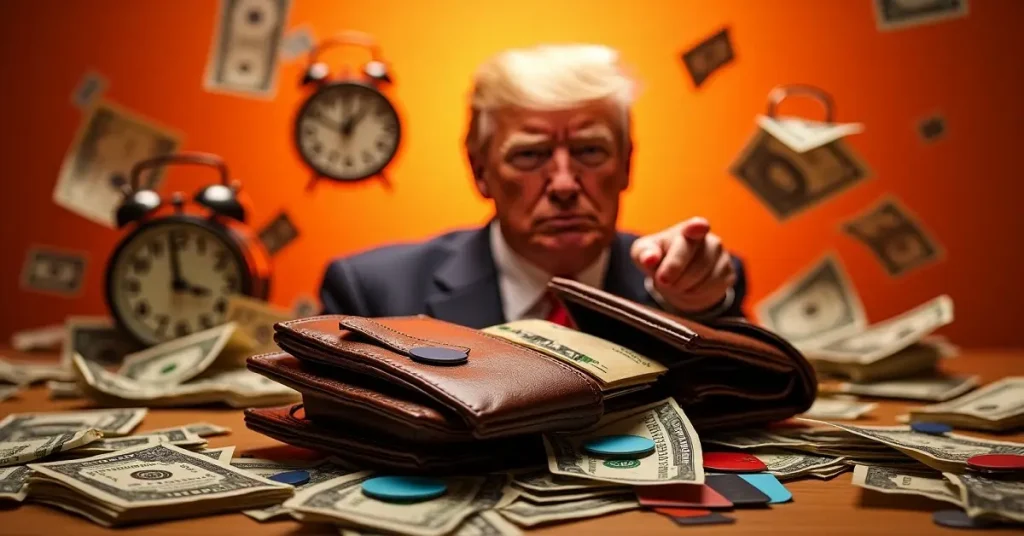In a dramatic turn of events, global stock markets plummeted on April 7, 2025, in what’s now being dubbed “Orange Monday”—a nod to U.S. President Donald Trump’s signature hue and the infamous “Black Monday” crash of 1987.
The catalyst? Trump’s sweeping tariffs on international trade partners, which sent shockwaves through financial hubs worldwide, leaving investors reeling and sparking fears of a looming recession.
Orange Monday Meltdown
The chaos began as Hong Kong’s Hang Seng Index nosedived 13.6%, marking its worst single-day drop since the 1997 Asian financial crisis, according to Al Jazeera.
The ripple effect was immediate: Taiwan’s market fell 9.6%, Japan’s Nikkei dropped 9.5%, and European markets like Italy and Germany saw declines of 8.4% and 6.8%, respectively, as reported by @visegrad24 on X. The S&P 500 in the U.S. officially entered bear market territory, dipping over 20% from its February peak, per @RpsAgainstTrump.
Read More: Tariff Turmoil Unleashes Global Market Chaos: Is This the Crash We’ve All Feared?
Social media erupted with the hashtag #OrangeMonday, as users like @themoneycoach warned, “Markets are crashing globally—not from natural cycles, but from Trump’s reckless economic decisions.
This is manufactured chaos, not normal volatility.” Accompanying the post was a striking image of Trump’s silhouette against a plummeting stock chart, encapsulating the day’s panic. Memes flooded X, with @virtaava sharing a satirical image of Trump as an orange with a plant sprouting from his head, captioned simply “#OrangeMonday.”
The root of the crisis lies in Trump’s aggressive tariff strategy. On April 6, Trump declared on Truth Social, “We have massive Financial Deficits with China, the European Union, and many others.
The only way this problem can be cured is with TARIFFS,” a sentiment echoed in his April 7 post urging the U.S. to “Be Strong, Courageous, and Patient” for “GREATNESS.” The U.S. imposed a 10% baseline tariff on all imports starting April 6, with steeper duties of 11% to 50% set to hit specific nations by April 9, per The Guardian. China retaliated with a 34% tariff on U.S. imports, while the EU and others threatened trade war countermeasures, as noted by Reuters.
The market’s volatility was exacerbated by a false rumor on X, reported by @unusual_whales, claiming a 90-day tariff pause was under consideration. Stocks briefly turned green before the White House debunked the rumor as “fake news,” sending markets back into the red.
The Nasdaq Composite, for instance, swung from a 4.3% drop to a 0.1% gain by day’s end, while the Dow Jones Industrial Average saw intraday fluctuations of over 1,700 points, according to the Hindustan Times.
Economists and business leaders sounded the alarm. JP Morgan raised its global recession odds to 60%, up from 40%, while JPMorgan Chase CEO Jamie Dimon warned that the tariffs could “exacerbate inflation” and “slow down growth.” Billionaire Bill Ackman called the situation a “self-induced economic nuclear winter,” and even Trump ally Elon Musk appeared to distance himself from the policy, per The Guardian.
On X, @AttorneyGriggs highlighted the human cost, noting, “No one voted for massive hits to their Roth IRAs,” while @deborahjbd countered, “Many don’t have a Roth IRA and are concerned about food and housing,” pointing to rising prices due to tariffs.
As the dust settles, the world watches anxiously. Will Trump double down on his tariff “medicine,” as he called it, or heed the growing chorus urging a policy reversal? One thing is clear: Orange Monday has left an indelible mark on global markets—and the fallout is far from over.
